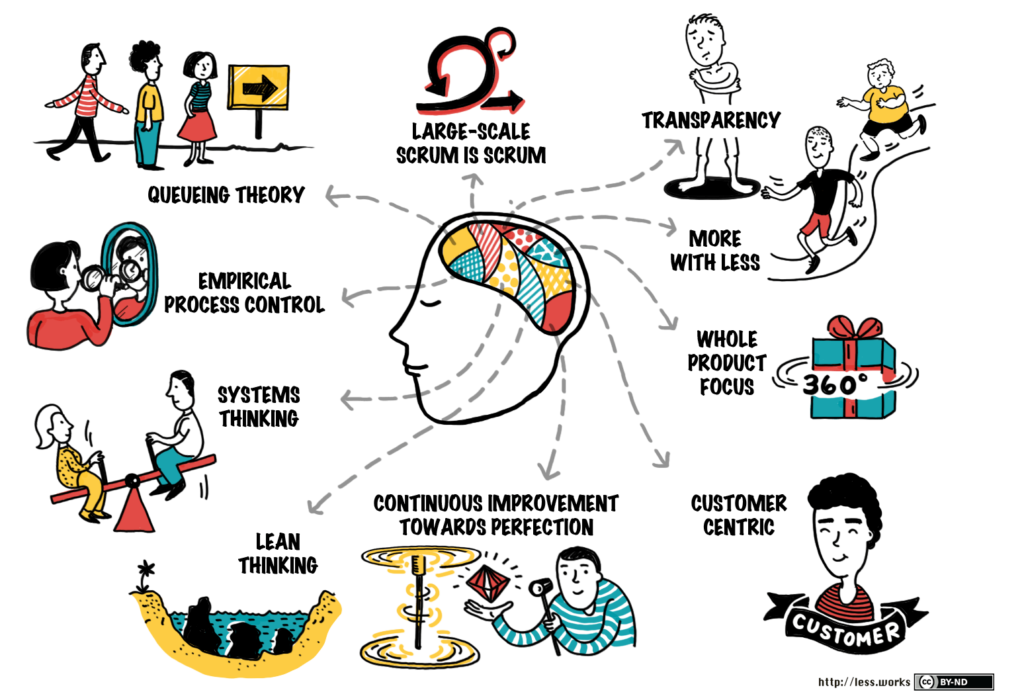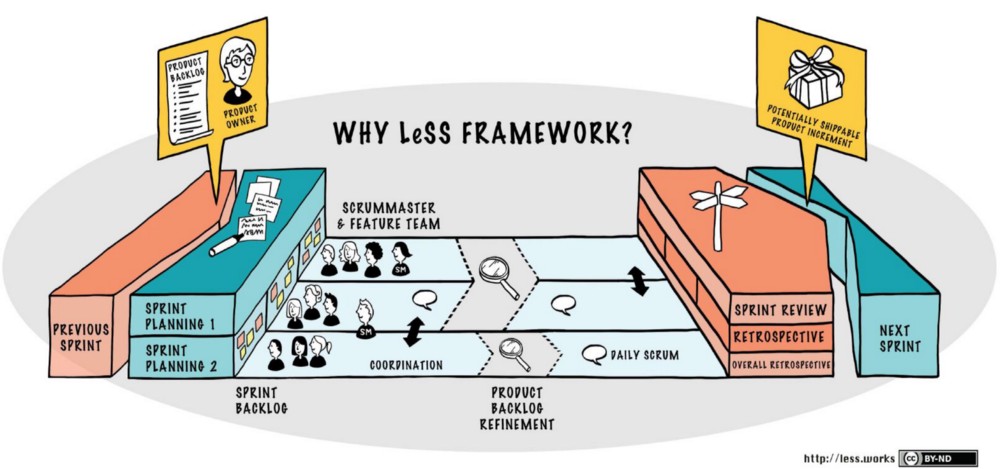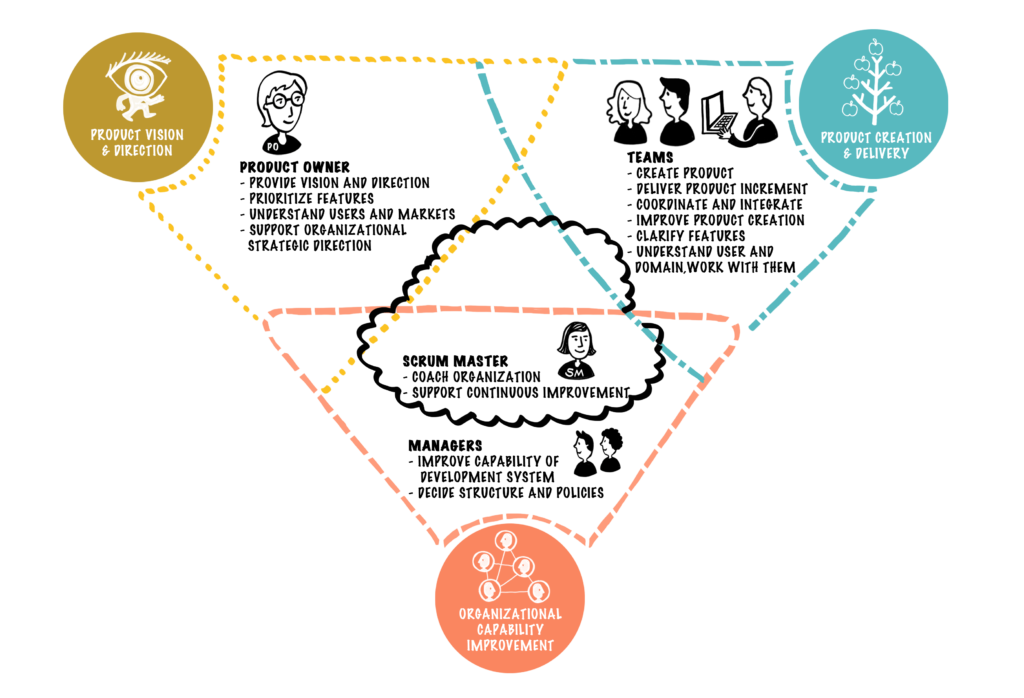LeSS (Large Scale Scrum) — an introduction


Agile teams include product owners, scrum masters and software developers. They work together to solve complex problems by creating valuable products. One of the most popular agile methods teams use to create, deliver, and sustain complex products is scrum. We have only recently been able to scale scrum within an enterprise using agile frameworks such as Large-Scale Scrum (LeSS).
What is the LeSS framework?
LeSS is a framework that scales scrum to multiple teams working together on a single product. It begins with one scrum team defined by Jeff Sutherland and Ken Schwaber in the Scrum Guide. It can be extended to multiple teams working on a single product.
This idea is further developed in the book Large-Scale Scrum: More with LeSS by Bas Vodde and Craig Larman. LeSS was created by the authors using their many years of experience. It is a framework that delivers value while reducing complexity and waste.
LeSS seeks to use the principles and ideals of scrum in large-scale enterprise contexts as easily as possible using defined rules and guides. LeSS has been labeled a “barely adequate” framework due to its simplicity, but this is not intended to make it look bad.
LeSS Framework Structure
LeSS was born out of more than 600 experiments. These included expanding scrum practice, which was thought only to be able to support small groups. The LeSS frameworks, guidelines, frameworks, and principles were developed to support larger teams. LeSS rules later became available to provide guidance and direction on implementing LeSS and facilitating adoption.
Principles of LeSS
LeSS defines 10 principles to apply the value, elements and overall purpose for scrum throughout an enterprise. They create responsible teams that are more customer-focused and collaborate better with each other. Teams are focused on learning, transparency and delivering customer-centric value that product companies need to be competitive and responsive. Here is the complete list.
- Large-Scale Scrum is scrum
- Empirical process control
- Transparency
- More with less
- Whole product focus
- Customer-centric
- Continuous improvement towards perfection
- Systems thinking
- Lean thinking
- Queuing theory
LeSS Frameworks
LeSS has two options: LeSS Basic for 2-8 people (10-50) and LeSS Large for 8-10 people (50-6000+).
LeSS Huge builds on the foundation of Basic LeSS and adds an important role, the APO (Area Product Owner) and additional artifacts. To get feedback and experiment with LeSS Huge, it’s a good idea to begin with, Basic LeSS within your organization. Two approaches are suggested for LeSS Huge adoption.
- Focus on one requirement at a given time.
- Gradually increasing the scope of work for the team and product definition.
This allows an organization to develop team experience with LeSS and expand within a product area. Management support is also available, allowing LeSS to be scaled throughout the organization.
LeSS Guides
Bas Vodde and Craig Larman created the LeSS guides based on their LeSS experiments. They were created as an unintended side effect of their third book “Large Scale Scrum: More With Less”. However, they can be very useful in helping you understand how to adopt LeSS, what roles and responsibilities are involved, how to coordinate between teams and how to integrate them. The guides can be used in conjunction with the LeSS framework.
Experiments
LeSS also includes experiments the authors recommend organizations do, some to avoid and others that have produced mixed results. LeSS was formed from the results of experiments.
Craig Larman & Bas Vodde’s first two books – “Scaling Lean & Agile Development” and “Practices for Scaling Lean & Agile Development” – set Large-Scale Scrum up as a series of experiments that demonstrates the principle that there is no “best practice” because they are always contextualized to their environment.
The author’s third book, “Large-Scale Scrum: More with LeSS,” contains guides to adopting LeSS, exercises from the first two books and clarifications of LeSS roles. It also explains how to integrate and coordinate between teams.
The framework was built incrementally in all three books. They are highly recommended for understanding the foundations of LeSS.
Planning and roles in LeSS
Basic LeSS is focused on the team and key scrum roles. These include the scrum product owner, who oversees product vision and direction; scrum development teams, who create and deliver the product; and the scrum master, who coaches and assists the team in continuous improvement. LeSS also discusses the manager’s role and how they can help the team remove barriers to continuous improvement and autonomy.
The LeSS Huge area product owner coordinates with the overall product owners and helps to connect the business and technical teams. The work of the area product owner is similar to that of the product owner, but they have a smaller scope and are more accountable for the support team. The area product owner is a specialist in customer-focused tasks. They also act as product owners for product-focused feature teams.
The Product Backlog Refinement meeting (PBR) is one of the most important ceremonies described in scrum. PBR meetings allow sprint planning to be expanded beyond the area of focus by executing parallel LeSS sprints. These meetings are essential for each sprint’s understanding, discussion, and refinement of items in preparation for future sprints. PBR meetings have three main activities:
- Break down big items.
- Clarify and answer any outstanding questions.
- Estimate how big the story, risks and dependencies are and what the values are.
The sprint planning ceremony is important, but the sprint review, retrospective, and sprint plan are essential ceremonies. They allow teams to look at what they have built and delivered and discuss improvements and new ideas. The sprint review and retrospective are also a chance for teams to recognize the customer value delivered. Each team has an opportunity to inspect and adapt through retrospectives. A retrospective also focuses on how the team collaborated and coordinated.
What is different about LeSS?
LeSS shares five components that are similar to other frameworks for scaling agile. These include inspiration from the Agile manifesto with its 12 principles, cadence through sprints/iterations and synchronization throughout the organization. It also has its roots in scrum and quality development practices like DevOps, CI/CD, and Test-Driven Development (TDD). Other distinctive characteristics make it stand out from the rest.
Scrum vs LeSS
It is common to compare LeSS and scrum to decide which one is better. This is not the best mindset. LeSS is not a “better” scrum, and there is simply no competition. LeSS is a way to extend scrum and scale it beyond one team.
Basic LeSS is very similar in structure to a scrum team. LeSS has a single product backlog and product owner. There is also a defined of done. Although the team may be made up of several teams, they work together as a scrum team to deliver a common product at each sprint’s end. LeSS allows multiple teams to work together, even though one product owner is responsible for a single product backlog. LeSS Huge is a special case where the product owner role has been expanded to include product owners who coordinate and collaborate with many teams. The product owner is responsible for the team’s product backlog refinement meeting. This helps to align work delivery across all teams.
LeSS also allows for sprint planning to be broken down into two parts.
- All teams meet together to determine the best way to divide the product backlog
- All teams plan their sprint while communicating and collaborating with other teams to deliver the product backlog items.
Other than these points, LeSS also includes other LeSS ceremonies, such as the daily scrum and sprint review.
LeSS vs SAFe
LeSS is becoming more popular in large enterprises with large software development teams. However, there are other agile frameworks like Scrum of Scrums and Scrum@Scale. The Scaled Agile framework(r) is one of the most popular.
LeSS and SAFe share many similarities. Both LeSS and SAFe share many similarities. For example, they begin with scaling a scrum group and incorporating lean thinking and continuous improvement principles. LeSS is different because it simplifies the organizational structure while remaining flexible and adaptable.
SAFe, contrary to LeSS, requires additional roles such as the Release Train Engineer, Solution Train Engineer (STE) and Epic Owners. The SAFe process, artifacts and organizational changes are all required. Some organizations may not be prepared to accept these roles, even though they have been able to compete with scrum teams that run agile projects. Although LeSS Huge has some differences from Basic LeSS, it is generally not as complicated as other frameworks.
Benefits of the LeSS framework
LeSS’s primary focus is not to create a new framework but to apply scrum principles to many teams that work together to provide a complete end-to-end, customer-centric solution or product.
LeSS can provide many benefits, including:
- Implementing practices teams already use in scrum can lower the cost of implementation.
- A product owner who can understand the principles and framework of the product can bridge the gap between technical and business teams.
- Few people are required to deliver a product, and leSS doesn’t exponentially increase the number of roles or overheads.
- It gives a complete product view in the focus area.
- Teams work directly with customers and business stakeholders.
- Regular retrospectives and other meetings are key components of the Agile Manifesto. This allows for continuous improvement.
LeSS may be the next step in many organizations’ journey to becoming agile.



